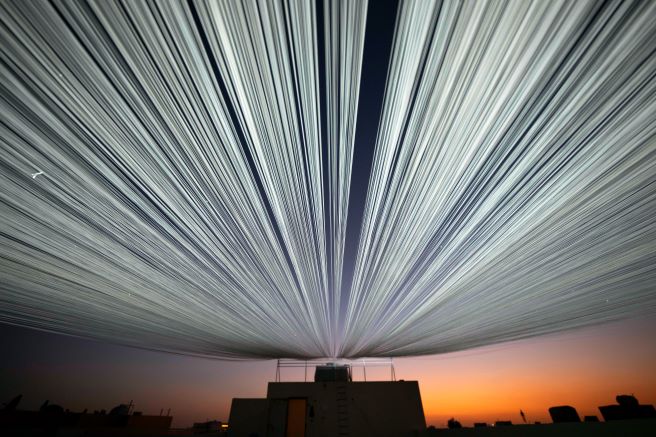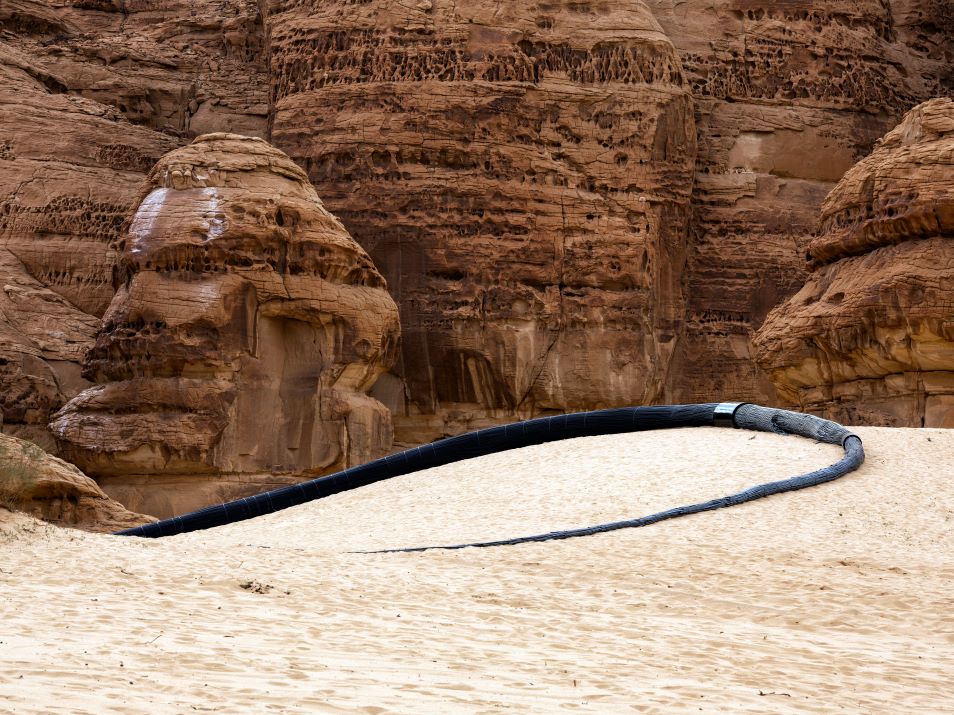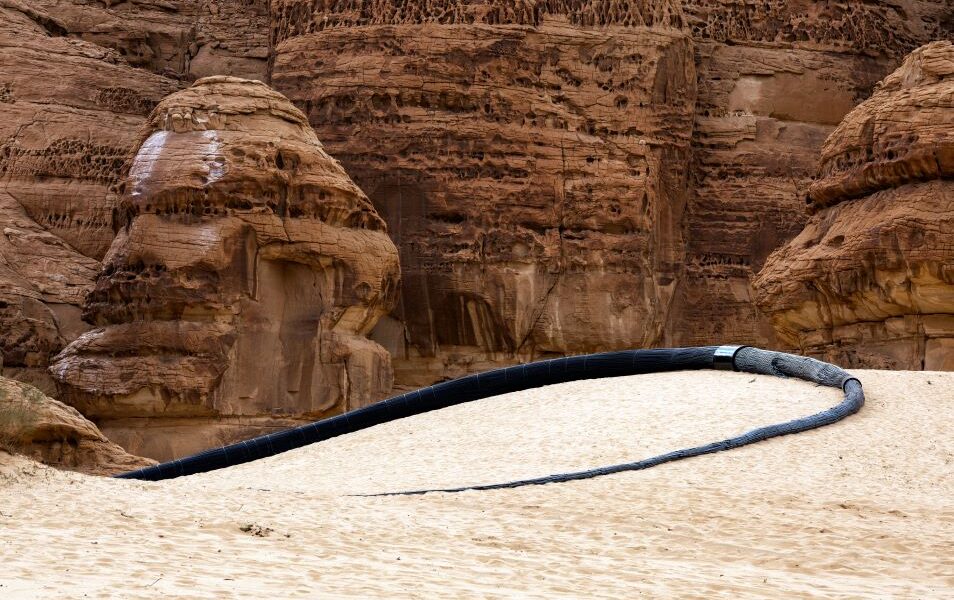Muhannad Shono
Sea and Saltwater
Rajesh Punj

In conversation, for everything that matters to what he is doing as an artist, it is the ethereal that plays to Muhannad Shono’s imagination, originally an illustrator, who moved from ink drawings and self-publishing to making art as installations, his work by his own definition, draws attention to a personal resolve and longstanding resistance against the real. For Shono, make-believe and the mythical have always mattered more, because they offered him a way out of the world, as he positioned himself in the shadows of the perceived ‘truth’. For all of his assuredness now if there was a choice between being faithful to the fables that have forged his country’s identity and a glimpse of the fanciful, the artist began more at ease with reclaiming the facts as his own, to conceive of very different endings. To go on to create works that are entirely about his desire to dream, and that they have their own fantastic space and place. That for their disruption enlightens one of a master narrative over the workings of the individual mind. Rewarded by a greater sense of freedom as fantasy, he is an attempt to graffiti over the official version of events, and let the characters and plot decide for themselves, with artworks that are restless rather than residing in the truth. Having gone on to represent Saudi Arabia at the Venice Biennale, with the ‘Teaching Tree’, and since appointed Contemporary Art Curator for the 2025 Islamic Biennale, Shono has come out of his pictorial shadows, to epitomise the energy and ambition of the new Kingdom.

Early works like The Nobodies 2015, show a colossal shadow of a man, who towers over a photographic image of an insignificant game of cricket, everyone anonymous, ‘nobodies’, rallying one another to run. Here entirely unaware of the giant standing over them, brazened with a bat of his own. Applying ink to photographic paper, as is characteristic of his work then, Shono takes an idyllic, somewhat uneventful encounter, caught on camera, to change and challenge the scene with the most improbable of creatures that he intends to terrorise the unsuspecting, but in a way that introduces a new perspective, rather than seeks to eradicate anything of the original event. Another work Judgemental of the same year shows two unidentifiable creature creations that have settled at the edge of, over a city, to appear to want to torment its citizens, and in 2016 Shono drew from the adventure of his photo fuelled drawings, to create Children of Yam, in which miniature figures, created as this pool of ink lines, becoming hundreds and for his restless determination, appear to flee the flat of the paper for an imagined black hole. The black and white of the paper, as much as the revelatory light and darkness of his imagination, takes us into the realm of what it is to imagine. This is what Shono wants of all of us, to turn the lights out, to leave the world behind, and let our minds create their own characters, to offer ourselves something entirely our own. And it is the endeavour of his stories, that mirror for him, the truths that have gone before, of ‘pages that cannot be opened now’, ‘of stories that cannot be read’, ‘and lessons that cannot be learned from’.
For Shono his ink protests are born of his inventive visions, and in the idea, as he insists, that we have to read and recycle what is written down, that is offered as evidence of the real, to be able to empower ourselves with everything of the other. Unearthing some of the sentiment of science fiction writers like Jules Verne and H.G. Wells, Shono’s 2019 work AL-MARS recites a sentimental nonsensical story of a young man and his father who witness alien activity of a kind that sees their world to have progressed to the point of annulation. This makes for an uneasy understanding of everything on earth as if these underground alternatives are our only rescue.
2019 saw Muhannad Shono turn his attention to greater works. Taking modern machine-made materials to dilapidated and derelict locations, Shono arranged 3,000 equally cut lengths of black pipe in a small space the size of a living room. With the door long since removed, the wooden French windows destroyed and partially having dropped to the grass-riddled ground, his installation appears as an act of unlikely art, of materials being loosely applied to the frame of the room, to create this swell of material threads that rise and ride up the walls, as though the sprouting of oil. In The Silence is Still Talking 2019, Shono considers the plight and position of the word, as giving our lives meaning – rewarding, redemptive, tantalising and tragic. And when everything of what we say has the possibility of including us in social groups or having us as easily removed from political eternities, Shono examines the word as an entity, visual, of volume, and violent when abused, with a work that is a physical find of what the word and language look like after their use, in political and corrupted situations, discoloured and even destroys of their original worth.
With works of charcoal on paper, involving ‘spectrums of sound’ to explore letters as words, words as meaning, and meanings as a matter of life or death. It is a work that leads us into the realms of Shono’s new appetite for something more sculptural, which has him take plastic piping and silicon wire, and have it create its own landscape, in stark opposition to what is around it. Works that led us to his most recent works, The Teaching Tree 2022, as exhibited at the Venice Biennale, and I See You Brightest in the Dark, of the same year, which was shown as part of a programme of events for Noor Riyadh and has since gone onto Jeddah, for their inaugural biennale. These are works that appear to draw on his original determination to dream, and as a practice create their own space and place. Leaving Muhannad Shono to his own thoughts, one feels there is so much to come from this country, for what he is finally able to do and where his visions will take him.

Interview
Rajesh Punj: As background, and by way of introduction, I have been invited to Riyadh to interview you for Sculpture, having been aware of you, and your work for some time now. I was here weeks before for Noor Riyadh and regrettably missed your installation I See You Brightest in the Dark entirely. It was mentioned many times by the other critics and curators I was there with. I have also seen many images, unfortunately, having not attended the biennale, of the recently exhibited The Teaching Tree (curated by Reem Fadda, whom I know very well, our having studied together in London), shown at the Saudi Arabia pavilion of the Venice Biennale, that caught a great deal of coverage. And with the black and white of those works in mind, I want to understand with you the moving or emotional monumentality of the work. Of how you see scale and space as atmospheres for art, that proves compelling, and then there is the reverential about the work, of the lives that exist and those that have since gone that are current to and carry the installations.

Muhannad Shono: I started by responding to attempts to restrict the imagination. Specifically censorship, and attempts to retract or even decapitate the human imagination. So the line was being used in the early works against the imagination, and I would manifest characters and roles in my mind, I felt that there was a fear of the imagined world and this telling of narrative at that time because it could change the lived world, and it was the fear I think that they had the establishment.
Read More>> Please Subscribe our Physical Magazine